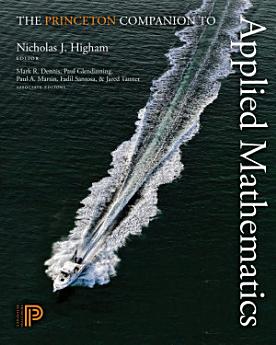The Princeton Companion to Applied Mathematics
Nicholas J. Higham · Mark R. Dennis · Paul Glendinning · Paul A. Martin · Fadil Santosa · Jared Tanner
កញ្ញា 2015 · Princeton University Press
4.2star
ការវាយតម្លៃ 4report
សៀវភៅអេឡិចត្រូនិច
1016
ទំព័រ
family_home
មានសិទ្ធិ
info
reportការវាយតម្លៃ និងមតិវាយតម្លៃមិនត្រូវបានផ្ទៀងផ្ទាត់ទេ ស្វែងយល់បន្ថែម
អំពីសៀវភៅអេឡិចត្រូនិកនេះ
The must-have compendium on applied mathematics
This is the most authoritative and accessible single-volume reference book on applied mathematics. Featuring numerous entries by leading experts and organized thematically, it introduces readers to applied mathematics and its uses; explains key concepts; describes important equations, laws, and functions; looks at exciting areas of research; covers modeling and simulation; explores areas of application; and more.
Modeled on the popular Princeton Companion to Mathematics, this volume is an indispensable resource for undergraduate and graduate students, researchers, and practitioners in other disciplines seeking a user-friendly reference book on applied mathematics.
This is the most authoritative and accessible single-volume reference book on applied mathematics. Featuring numerous entries by leading experts and organized thematically, it introduces readers to applied mathematics and its uses; explains key concepts; describes important equations, laws, and functions; looks at exciting areas of research; covers modeling and simulation; explores areas of application; and more.
Modeled on the popular Princeton Companion to Mathematics, this volume is an indispensable resource for undergraduate and graduate students, researchers, and practitioners in other disciplines seeking a user-friendly reference book on applied mathematics.
- Features nearly 200 entries organized thematically and written by an international team of distinguished contributors
- Presents the major ideas and branches of applied mathematics in a clear and accessible way
- Explains important mathematical concepts, methods, equations, and applications
- Introduces the language of applied mathematics and the goals of applied mathematical research
- Gives a wide range of examples of mathematical modeling
- Covers continuum mechanics, dynamical systems, numerical analysis, discrete and combinatorial mathematics, mathematical physics, and much more
- Explores the connections between applied mathematics and other disciplines
- Includes suggestions for further reading, cross-references, and a comprehensive index
ការដាក់ផ្កាយ និងមតិវាយតម្លៃ
4.2
ការវាយតម្លៃ 4
អំពីអ្នកនិពន្ធ
Nicholas J. Higham is the Richardson Professor of Applied Mathematics at The University of Manchester. Mark R. Dennis is professor of theoretical physics at the University of Bristol. Paul Glendinning is professor of applied mathematics at The University of Manchester. Paul A. Martin is professor of applied mathematics at the Colorado School of Mines. Fadil Santosa is professor of mathematics at the University of Minnesota. Jared Tanner is professor of the mathematics of information at the University of Oxford.
វាយតម្លៃសៀវភៅអេឡិចត្រូនិកនេះ
ប្រាប់យើងអំពីការយល់ឃើញរបស់អ្នក។
អានព័ត៌មាន
ទូរសព្ទឆ្លាតវៃ និងថេប្លេត
ដំឡើងកម្មវិធី Google Play Books សម្រាប់ Android និង iPad/iPhone ។ វាធ្វើសមកាលកម្មដោយស្វ័យប្រវត្តិជាមួយគណនីរបស់អ្នក និងអនុញ្ញាតឱ្យអ្នកអានពេលមានអ៊ីនធឺណិត ឬគ្មានអ៊ីនធឺណិតនៅគ្រប់ទីកន្លែង។
កុំព្យូទ័រយួរដៃ និងកុំព្យូទ័រ
អ្នកអាចស្ដាប់សៀវភៅជាសំឡេងដែលបានទិញនៅក្នុង Google Play ដោយប្រើកម្មវិធីរុករកតាមអ៊ីនធឺណិតក្នុងកុំព្យូទ័ររបស់អ្នក។
eReaders និងឧបករណ៍ផ្សេងទៀត
ដើម្បីអាននៅលើឧបករណ៍ e-ink ដូចជាឧបករណ៍អានសៀវភៅអេឡិចត្រូនិក Kobo អ្នកនឹងត្រូវទាញយកឯកសារ ហើយផ្ទេរវាទៅឧបករណ៍របស់អ្នក។ សូមអនុវត្តតាមការណែនាំលម្អិតរបស់មជ្ឈមណ្ឌលជំនួយ ដើម្បីផ្ទេរឯកសារទៅឧបករណ៍អានសៀវភៅអេឡិចត្រូនិកដែលស្គាល់។





